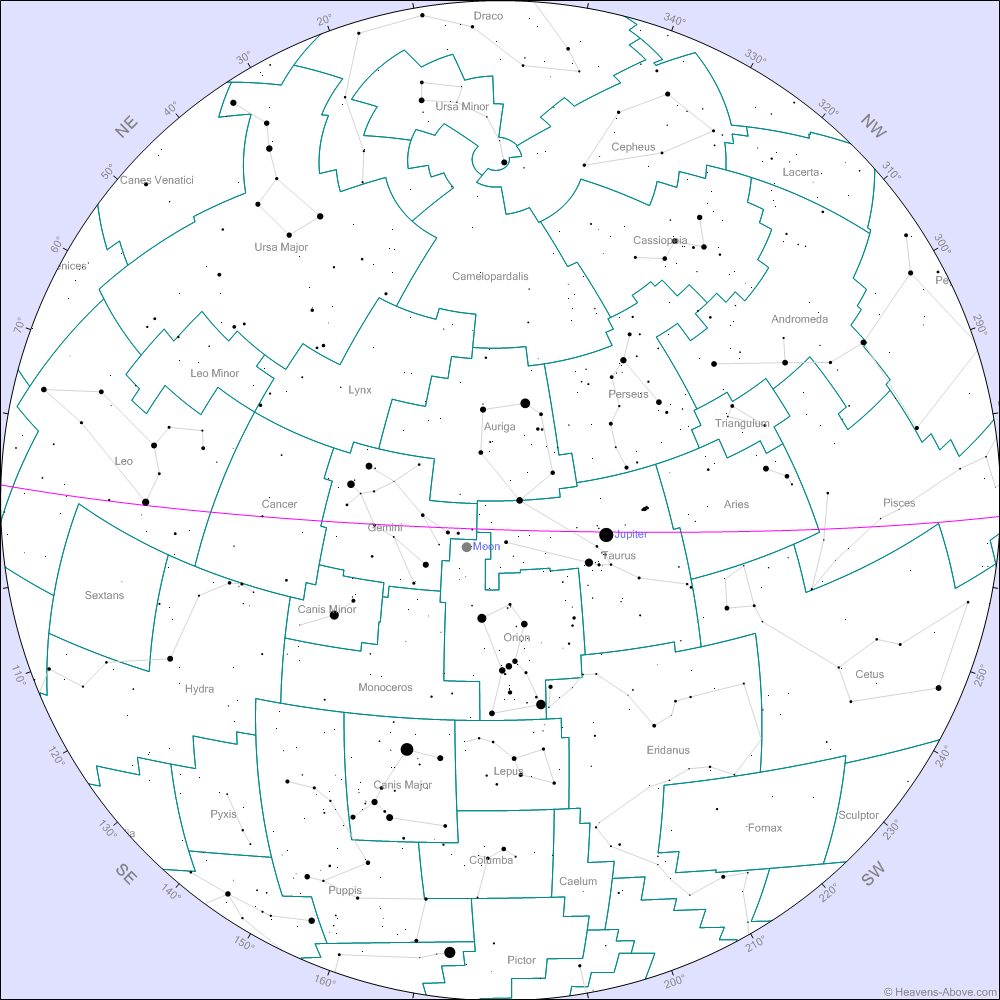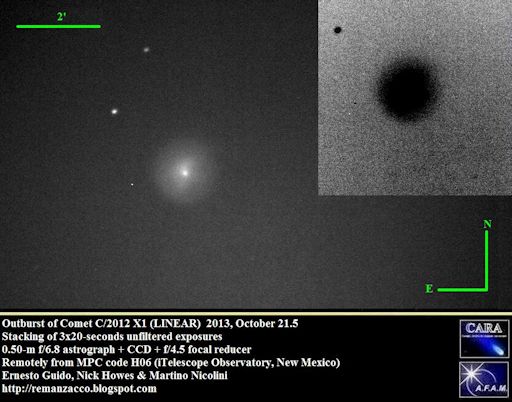Sky this week
February 2013
sixth and seventh Week
6 Feb - 19 Feb, 2013
February 08 Ganymede Shadow Transit
February 11 Io Shadow Transit
February 12 -5 mag Iridium flare from delhi at 19:45 IST
February 13 Io Shadow Transit
February 15 Ganymede Shadow Transit
February 15 Asteroid 2012DA14 passes within 27,000 kms of earth
February 16 -4 mag Iridium flare from delhi at 06:03 IST
February 17 -5 mag Iridium flare from delhi at 05:57 IST
February 17 -5 mag Iridium flare from delhi at 19:32 IST
Sun rise/set and Moon rise/set data
6 Feb 2013 07:06 18:04
7 Feb 2013 07:06 18:05
8 Feb 2013 07:05 18:06
9 Feb 2013 07:04 18:07
10 Feb 2013 07:03 18:08
11 Feb 2013 07:03 18:08
12 Feb 2013 07:02 18:09
13 Feb 2013 07:01 18:10
14 Feb 2013 07:00 18:11
15 Feb 2013 07:00 18:11
16 Feb 2013 06:59 18:12
17 Feb 2013 06:58 18:13
18 Feb 2013 06:57 18:14
19 Feb 2013 06:56 18:14
6 Feb 2013 03:13 14:02
7 Feb 2013 04:11 15:06
8 Feb 2013 05:06 16:11
9 Feb 2013 05:55 17:17
10 Feb 2013 06:40 18:21 New Moon at 1250
11 Feb 2013 07:21 19:23
12 Feb 2013 07:59 20:23
13 Feb 2013 08:36 21:21
14 Feb 2013 09:13 22:18
15 Feb 2013 09:50 23:13
16 Feb 2013 10:29 -
17 Feb 2013 11:09 00:07
18 Feb 2013 11:53 01:00 First Quarter at 02:01
19 Feb 2013 12:39 01:51
This weeks HOT news - An asteroid slightly bigger than the size of India Gate will pass within the Geosynchronous satellite orbit
Imagine a space rock as big as the india gate (as far as the height if india gate in terms of size) passing within the geosynchronous orbit and going back to the deep abyss of space. It looks like a Science fiction story but it is for real!!! On 15th Feb, this is exactly going to happen. 2012 DA14, a recently discovered asteroid (like the one our student have been discovering since last 3 years in the AIASC campaigns) will pass within 34, 000 kms from the centre of the earth (make it 27, 000 kms from the ground!!) making it the one of the closest flybys for an asteroid of this size for earth.
2012 DA14 is a near-Earth asteroid with an estimated diameter of about 45 meters (148 ft) and an estimated mass of about 130,000 metric tons. It was discovered on February 23, 2012, by the OAM Observatory, La Sagra in Spain
The Asteroid 2012 DA14 will pass below distance where many commercial satellites are orbiting. It will pass inside the geosynchronous satellite ring, located about 35,800 km above the equator. The nominal pass will be 0.00023 AU (34,000 km; 21,000 miles) from the center of the Earth.
It is expected that the asteroid will travel rapidly from the southern evening sky into the northern morning sky on February 15, 2013. About 4 minutes after its Earth close approach, there is a good chance it will pass into the Earth’s shadow for about 18 minutes or so before reappearing from the eclipse. When traveling rapidly into the northern morning sky, 2012 DA14 will quickly fade in brightness.
With such a close approach to Earth, our planet’s gravity will change its future path and rise a chance of future impact. There is an estimated cumulative 0.033% risk (1 in 3,030) of 2012 DA14 impacting Earth sometime between 2026 and 2069. Some scientist believe that similar-in-size object hit Tunguska in 1918. If it were to strike the Earth, it is estimated that it would produce the equivalent of 2.4 megatons of TNT. The Tunguska event has been estimated at 3−20 megatons. Observing 2012 DA14 will provide a good test as we anticipate the 2029 flyby of Apophis, a bigger asteroid (around 270 meters) that is expected to have a very close encounter too, at around 36,000 kilometers.
Asteroid 2012 DA14 will pass by Earth at distance of about 27,000 km (17,000 mile) from the Earth. Just for comparison – 400-meters wide asteroid YU 55 passed 320,000 kilometers (200,000 miles) from Earth on November 8, 2011. Even closer flyby of asteroid 2011 MD last June was closer than DA14 will at a distance of only 12,070 km (7,500 miles). But one thing is almost certain – it will surely miss us! For now, the orbit of 2012 DA14 is such that it will not crash into Earth for the foreseeable future
The 2013 close approach to Earth will reduce the orbital period of 2012 DA14 from 368 days to 317 days. The next notable close approach to Earth will be on 16 February 2046 when the asteroid will pass no closer than 0.0004 AU (60,000 km; 37,000 mi) from the center-point of Earth. Check out the SPACE calender at www.space-india.org to know the exact details.
For Iridium flare also check out the SPACE Calender at www.space-india.org There are no ISS passe sin the night for the week.
Constellation of the Week:
Auriga is one of the 48 constellations listed by the Ptolemy and remains one of the 88 modern constellations. Located north of the celestial equator, its name is the Latin word for "charioteer", associating it with various mythological charioteers. Auriga is most prominent during winter evenings in the Northern Hemisphere, along with the five other constellations that have stars in the Winter Hexagon asterism. Because of its northern declination, Auriga is only visible as far as 34° south; for observers farther south it lies partially or fully below the horizon. A large constellation, with an area of 657 square degrees, it is half the size of the largest constellation, Hydra.
Its brightest star, Capella, is an unusual multiple star system among the brightest stars in the night sky. In ancient Hindu astronomy, Capella represented the heart of Brahma. Beta Aurigae is an interesting variable star in the constellation.
Epsilon Aurigae, a nearby eclipsing binary with an unusually long period, has been studied intensively. Because of its position near the winter Milky Way.The most prominent variable star in Auriga is Epsilon Aurigae is an eclipsing binary with an unusually long period of 27 years; its last minima occurred from 1982–1984 and 2009–2011.The distance to the system is disputed, variously cited as 4600 and 2170 light-years.The primary is a white supergiant, and the secondary may be itself a binary star within a large dusty disk. Its maximum magnitude is 3.0, but it stays at a minimum magnitude of 3.8 for around a year; its most recent eclipse began in 2009. The primary has an absolute magnitude of −8.5 and an unusually high luminosity of 200,000 L, the reason it appears so bright at such a great distance. Epsilon Aurigae is the longest-period eclipsing binary currently known. The first observed eclipse of Epsilon Aurigae occurred in 1821, though its variable status was not confirmed until the eclipse of 1847–1848. From that time forward, many theories were put forth as to the nature of the eclipsing component. Epsilon Aurigae also has a non eclipsing component, which is visible as a 14th magnitude companion separated from the primary by 28.6 arcseconds. It was discovered by Sherburne Wesley Burnham in 1891.
Deep sky objects of the week:
Auriga has many bright open clusters in its borders, including M36, M37, and M38, popular targets for amateur astronomers. In addition, it has one prominent nebula, the Flaming Star Nebula, associated with the variable star AE Aurigae.
M36: Open Cluster M36 (also known as Messier Object 36, Messier 36, M36, or NGC 1960) is an open cluster in the Auriga constellation. It was discovered by Giovanni Batista Hodierna before 1654. M36 is at a distance of about 4,100 light years away from Earth and is about 14 light years across. There are at least sixty members in the cluster. The cluster is very similar to the Pleiades cluster (M45), and if it were the same distance from Earth it would be of similar magnitude.
M37: Messier 37 (also known as M37 or NGC 2099) is the richest open cluster in the constellation Auriga. It is the brightest of three open clusters in Auriga and was discovered by the Italian astronomer Giovanni Battista Hodierna before 1654. M37 was missed by French astronomer Guillaume Le Gentil when he rediscovered M36 and M38 in 1749. French astronomer Charles Messier independently rediscovered M37 in September of 1764 but all three clusters were recorded by Hodierna.
M38: Messier 38 (also known as M38 or NGC 1912) is an open cluster in the Auriga constellation.
It was discovered by Giovanni Batista Hodierna before 1654 and independently found by Le Gentil in 1749. M36 and M37, also discovered by Hodierna, are grouped together with M38 at a distance of about 3,420 light years away from Earth. The cluster's brightest stars form a pattern resembling the Greek letter Pi or, according to Webb, an "oblique cross." At its distance of 4,200 light years, its angular diameter of about 20' corresponds to about 25 light years, similar to that of its more distant neighbor M37.
Flaming star nebula: IC 405 (also known as the Flaming Star Nebula, SH 2-229, or Caldwell 31) is an emission/reflection nebula[1] in the constellation Auriga, surrounding the bluish star AE Aurigae. It surrounds the irregular variable star AE Aurigae and is located near the emission nebula IC 410, the open clusters M38 and M36, and the naked-eye K-class star Hassaleh. The nebula measures approximately 37.0' x 19.0', and lies about 1,500 light-years away.

Sky at night at 8:00 pm on 20th Feb, 2013
Written by Sachin Bahmba and C B Devgun

